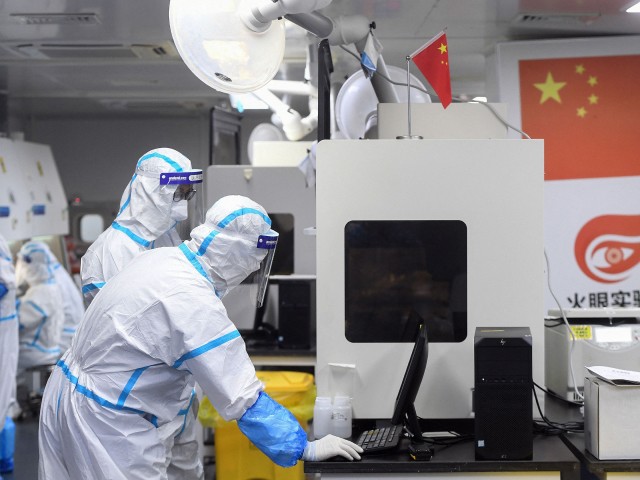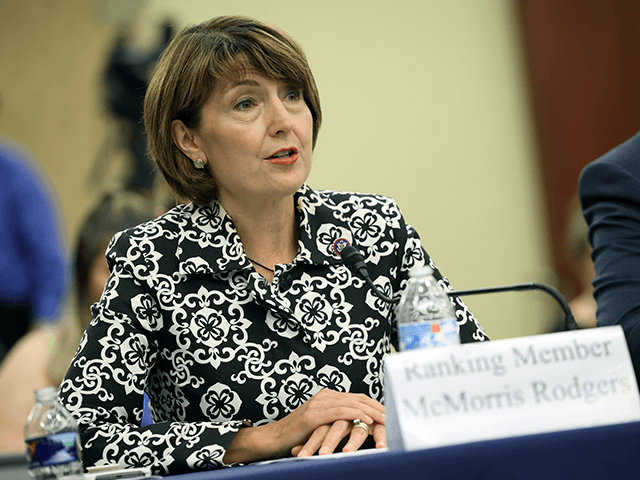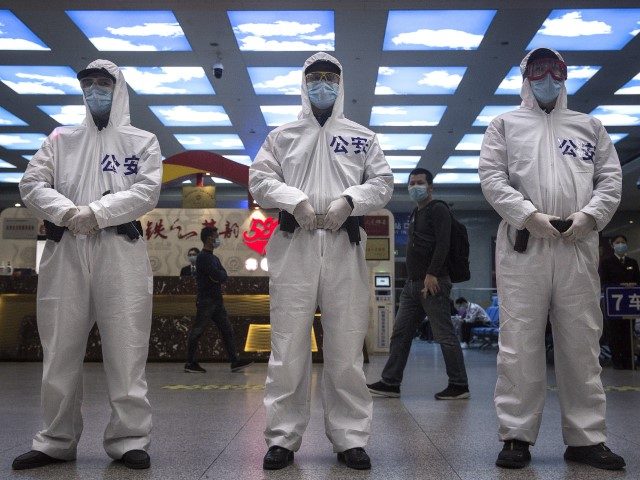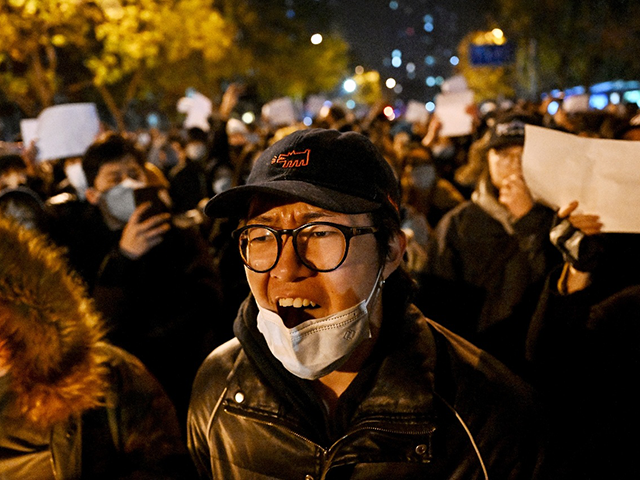The House Energy and Commerce Committee on Wednesday revealed evidence that a Chinese scientist possessed and attempted to share the gene sequence for the Wuhan coronavirus on December 28, 2019, two weeks before the Communist Party finally shared the sequence with the world.
The revelation follows years of mounting evidence that the Communist Party attempted to cover up the initial outbreak of novel coronavirus in Wuhan, China, and hid critical information that could have allowed for more rapid development of medical treatments, ultimately saving lives. The Chinese government did not concede the discovery of a novel virus spreading among humans in Wuhan until January and spent much of that month insisting that the virus was not transmissible from person to person, a false claim the World Health Organization (W.H.O.) readily amplified. Chinese officials destroyed early samples of the virus, making it impossible for scientists to study its evolution beginning with the first known cases infecting human beings.
The Communist Party also silenced doctors and other health workers whose first-hand experience with patients suggested the virus was contagious, forcing them to offer humiliating apologies for suggesting to fellow health workers that they wash their hands and wear protective gear when treating respiratory disease patients. In Wuhan, local authorities held mass gatherings of tens of thousands of people and let five million people leave the city before locking it down in response to growing international pressure on January 22, 2020.
According to a House Energy and Commerce committee statement on Wednesday, scientist Lili Ren of the Chinese Academy of Medical Sciences uploaded a genetic sequence of the coronavirus, which the W.H.O. formally named “SARS-CoV-2,” to a database run by the U.S. National Institutes of Health (NIH), known as GenBank on December 28, 2019.
“Dr. Ren’s submission was missing some of the technical (not scientific) information required for publication on GenBank,” the House committed revealed. “She was notified by NIH staff on December 31, 2019, that her submission would be deleted without the additional information.”
Ren reportedly never resubmitted the information; it remains unclear at press time why, particularly given that the sequence ultimately published did not look significantly different from Ren’s.
The revelations published on Wednesday are consistent with a House Foreign Affairs Committee report published in June 2020, which found that a local Wuhan laboratory had processed viral samples on December 27, which found the pathogen in question was a novel coronavirus. The China CDC was reportedly notified that the Wuhan virus was 87 percent similar genetically to the coronavirus responsible for Severe Acute Respiratory Syndrome (SARS) on that date.

This photo taken on August 4, 2021, shows laboratory technicians wearing personal protective equipment (PPE) working on samples to be tested for the COVID-19 coronavirus at the Fire Eye laboratory, a COVID-19 testing facility, in Wuhan in China’s central Hubei province (STR/AFP via Getty Images).
The 2020 House report found that the Wuhan Institute of Virology (WIV), a top scientific institute known to have been studying coronaviruses at the time of the outbreak, completed genetic mapping of the Wuhan coronavirus on January 2; Chinese authorities also reportedly had a second laboratory in Shanghai complete genetic sequencing for the virus on January 5.
The Chinese Center for Disease Control (CDC) published a gene sequence for the virus on January 10, 2020, which “was nearly identical” to Ren’s. Genetic sequences of pathogens are pivotal for the development of testing supplies to confirm infections and to research medical interventions against the pathogen.
“China has consistently stated that it published the genetic sequence of SARS-CoV-2 as soon as it was available,” the House committee noted.
Ren appeared to have the genetic sequence of the virus during a time in which China was still insisting the virus was not transmissible from human to human and three days before the government of Taiwan notified the W.H.O. that it had evidence that a contagious disease was spreading in Wuhan.
“News resources today indicate that at least seven atypical pneumonia cases were reported in Wuhan, CHINA,” an email from Taiwan’s Central Epidemic Command Center (CECC) to W.H.O. leaders on December 31, 2019, read. “Their [China’s] health authorities replied to the media that the cases were believed not SARS [Sudden Acute Respiratory Syndrome, the disease typically associated with the phrase ‘atypical pneumonia’]; however the samples are still under examination, and cases have been isolated for treatment.”
Patients would not be “isolated” for treatment for a disease that health workers do not have reason to believe is contagious.
“I would greatly appreciate if you have relevant information to share with us,” the Taiwanese email concluded.
The W.H.O. did not reply to the message, nor did it appear to take any meaningful action in response.
“Taiwan did report our concern on the severity of coronavirus last December to the WHO,” Taiwan’s representative office in the United States confirmed to Breitbart News in April 2020. “But as a rule, our reporting is always a one-way street. WHO mostly ignored our messages and never shared information as they do to other countries.”
The W.H.O. does not allow Taiwan to participate in its global health experts and does not recognize its sovereignty to avoid angering the Chinese Communist Party, which falsely claims Taiwan is a rogue Chinese province.
Three of the lawmakers on the House Energy and Commerce Committee – Rep. Cathy McMorris Rodgers (R-WA), Rep. Brett Guthrie (R-KY), and Rep. Morgan Griffith (R-VA) – issued a joint statement condemning the Chinese government’s secrecy and intransigence in the early days of the pandemic.

U.S. Rep. Cathy McMorris Rodgers (R-WA) testifies during a Republican-led forum on the origins of the COVID-19 virus at the U.S. Capitol on June 29, 2021, in Washington, DC. The forum examined the theory that the coronavirus came from a lab in Wuhan, China (Photo by Kevin Dietsch/Getty Images).
“This significant discovery further underscores why we cannot trust any of the so-called ‘facts’ or data provided by the CCP [Chinese Communist Party] and calls into serious question the legitimacy of any scientific theories based on such information,” the congresspersons said, adding,
The American people deserve to know the truth about the origins of SARS-CoV-2, and our investigation has uncovered numerous causes for concern, including how taxpayers’ dollars are spent, how our government’s public health agencies operate, and the need for more oversight into research grants to foreign scientists.
A two-week delay in global scientists having access to a novel virus’s genetic sequence could have a massive impact on public health officials’ ability to treat and contain a disease outbreak, experts said following the publication of the new information.
“That two weeks would have made a tangible difference in quite a few people’s lives,” Jesse Bloom, a virologist at the Fred Hutchinson Cancer Center in Seattle, told the Washington Post.
The Post also spoke to the former head of the Food and Drug Administration (FDA), Scott Gottlieb, who urged the world to “get to the bottom of – why the normal activity you’d expect among scientists trying to investigate an unusual pathogen got squelched by government authorities.”


COMMENTS
Please let us know if you're having issues with commenting.